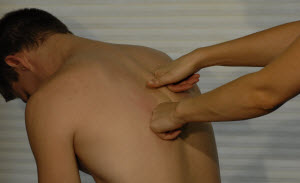Often clients come to us to relieve some sort of pain they may be experiencing. While Rolfing does alleviate symptoms, we do not diagnose illness or disease. Treatments are meant to be therapeutic and may not cure your conditions. Below are some of the most common areas of the body that cause chronic pain and how they may relate to your current aliment.
Back

Back pain is one of the most common complaints that we hear from clients who seek us out. It’s no surprise due to the back’s complex network of nerves leading to all areas of the body. These intertwining components can cause pain in all areas of the back, neck and surrounding regions.
To understand how Rolfing affects the back, it is important to recognize that back pain is not the single component involved. Following the theory of Rolfing, the blocks surrounding the spine – the head, pelvis, legs and feet need to align with the spine, or the entire skeleton becomes deformed. Rolfing intends to loosen the fascia, resulting in a freedom of muscle movement that allows the body to break free of old holding patterns that started the back pain. New aligned curves are formed in the spine and muscles are no longer being misused.
Do you suffer from herniated discs as well? Rolfing helps with that too. By manipulating the connective tissue around the area, we create space between the compressed discs, lengthening the spine and relieving the pressure.
Neck
 The consequences of imbalances are surprisingly great. When the body’s blocks shift in various directions out from the vertical axis, and are no longer stacked on top of one another, both skeleton and musculature are forced into an inefficient weight-bearing function. For example, in a common un-Rolfed body, the head is no longer being carried skyward by the cervical spine, instead, the muscles of the neck and upper back, designed as dynamic guide wires to move and balance the head are forced into the chronic tension required to support its weight. The function of most muscles is to contract in order to bring about movement, or release to prepare for new movement. When they consistently supporting a bony structure, such as your head, strain spreads through the facial network. The body will then lock up and joints loose their freedom. This can also bring about headaches, vision impairment and adjusted vertebra. Once the head shifts back over the trunk, muscles can relax and order is restored.
The consequences of imbalances are surprisingly great. When the body’s blocks shift in various directions out from the vertical axis, and are no longer stacked on top of one another, both skeleton and musculature are forced into an inefficient weight-bearing function. For example, in a common un-Rolfed body, the head is no longer being carried skyward by the cervical spine, instead, the muscles of the neck and upper back, designed as dynamic guide wires to move and balance the head are forced into the chronic tension required to support its weight. The function of most muscles is to contract in order to bring about movement, or release to prepare for new movement. When they consistently supporting a bony structure, such as your head, strain spreads through the facial network. The body will then lock up and joints loose their freedom. This can also bring about headaches, vision impairment and adjusted vertebra. Once the head shifts back over the trunk, muscles can relax and order is restored.
Knees
 Joints lose their ease of movement not only from the tightening of fascial planes which cross them, but also from their neighboring body parts. As two body part that relate to one another through a common joint lose the integrity of their relationship, the articulating surfaces of the joint itself do not meet evenly and pull on the joint with different forces. If the bones of the lower leg, for examples are twisted outward and the bone of the thigh inward, a common situation, the knee is likely to be troublesome or unstable. The surrounding muscles of the upper and lower legs are not tracking evenly and therefore will pull on the joint unevenly. Rolfing brings back the integrity of the joints and balances the surrounding muscles to create a working hinge for your knee.
Joints lose their ease of movement not only from the tightening of fascial planes which cross them, but also from their neighboring body parts. As two body part that relate to one another through a common joint lose the integrity of their relationship, the articulating surfaces of the joint itself do not meet evenly and pull on the joint with different forces. If the bones of the lower leg, for examples are twisted outward and the bone of the thigh inward, a common situation, the knee is likely to be troublesome or unstable. The surrounding muscles of the upper and lower legs are not tracking evenly and therefore will pull on the joint unevenly. Rolfing brings back the integrity of the joints and balances the surrounding muscles to create a working hinge for your knee.
Visceral (Internal Organs)
Circulation is restricted as the body tightens because the vessels run in and through the facial network. Think of this like a pillowcase that is too small for the pillow with little room between the pillow and the case. The depression of the upper chest; a consequence in part of shifting forward the head, limits freedom in the abdominal and pelvic cavities often impairing function. Swayback for example spills the abdominal viscera forward into a protruding abdomen changing the relationships between organs and the direction of pressures on them. This can appear as a “pot belly” when in actuality, it’s the position of the pelvis spilling over the guts. Symptoms can also include abdominal pain, lightheadedness, nausea, constipation, infertility and high blood pressure.
